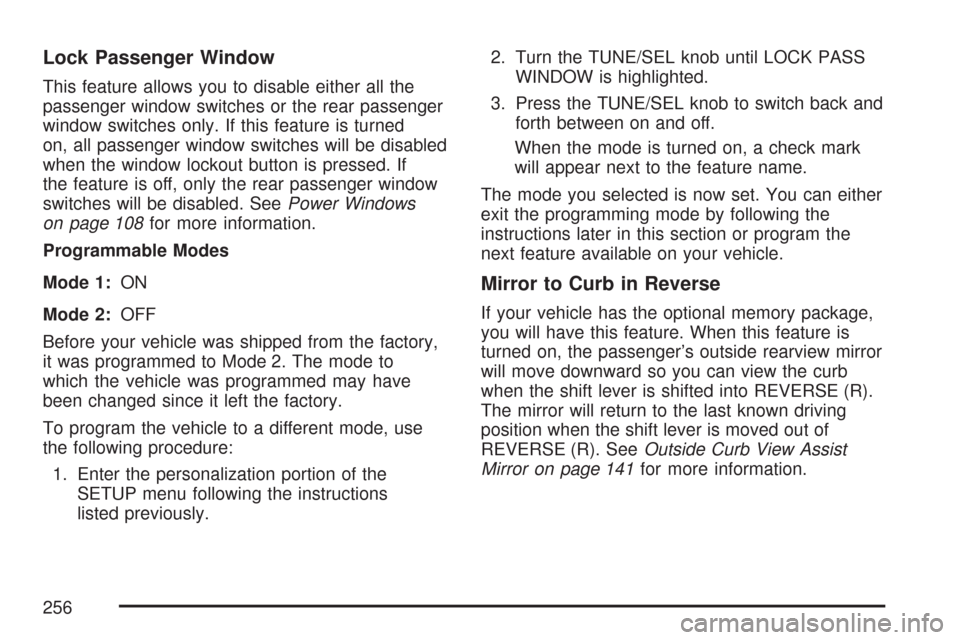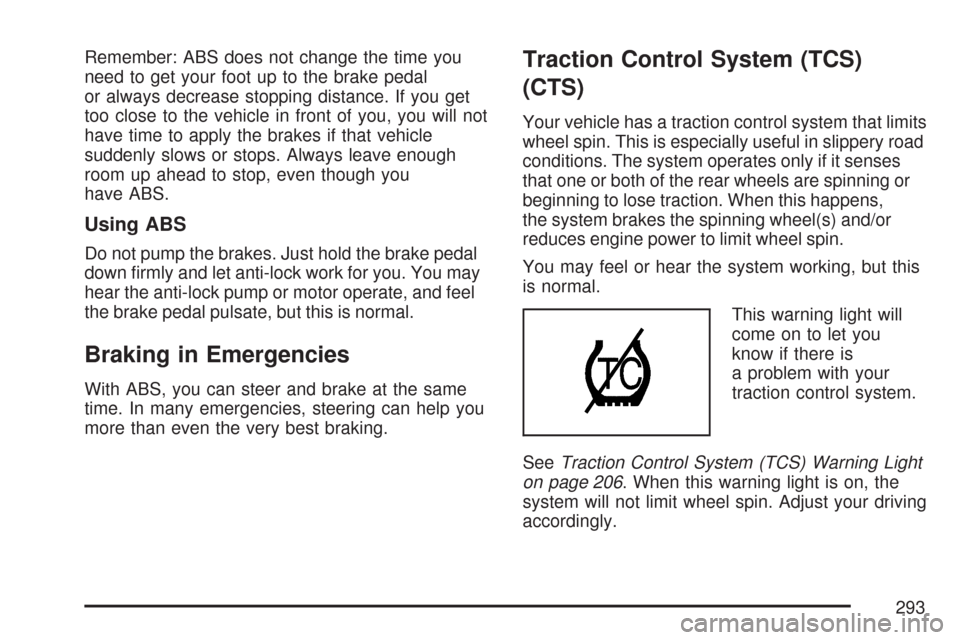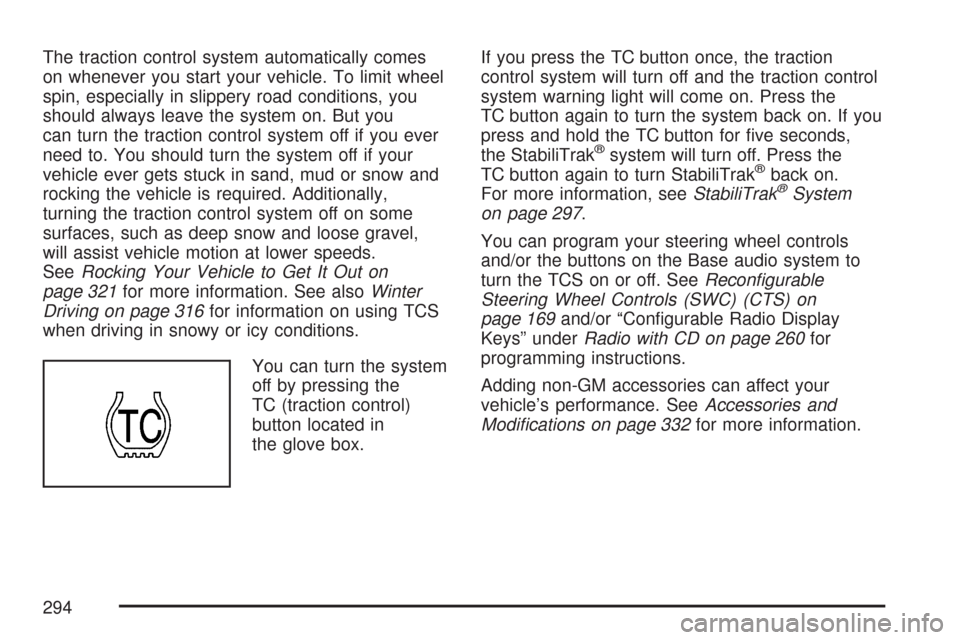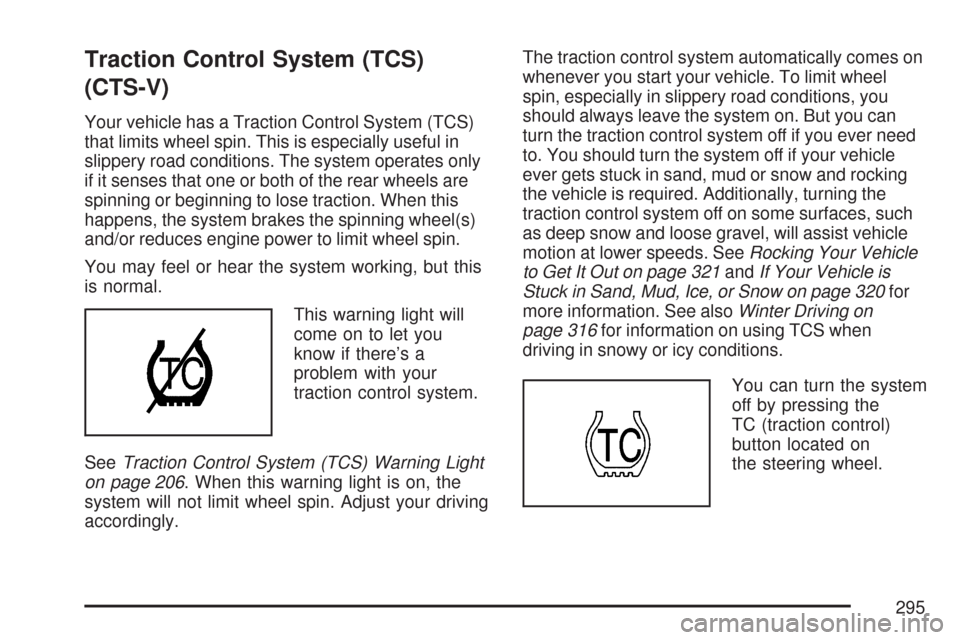light CADILLAC CTS 2007 1.G Owners Manual
[x] Cancel search | Manufacturer: CADILLAC, Model Year: 2007, Model line: CTS, Model: CADILLAC CTS 2007 1.GPages: 518, PDF Size: 2.77 MB
Page 255 of 518

To program the vehicle to a different mode, use
the following procedure:
1. Enter the personalization portion of the
SETUP menu following the instructions
listed previously.
2. Turn the TUNE/SEL knob until DOORS
UNLOCK KEY OUT/OFF is highlighted.
3. Press the TUNE/SEL knob to switch between
on and off.
When the mode is turned on, a check mark
will appear next to the feature name.
If this feature is selected, Doors Unlock in Park
(automatic transmission), Driver Unlock in
Park (automatic transmission), or Driver Unlock
Key Out/Off cannot be selected.
The mode you selected is now set. You can either
exit the programming mode by following the
instructions later in this section or program the
next feature available on your vehicle.
Delayed Locking
This feature delays the locking of the vehicle’s
doors for up to �ve seconds after a power door lock
switch or the lock button on the Remote Keyless
Entry (RKE) transmitter is pressed. The �ve second
delay occurs after the last door is closed.Programmable Modes
Mode 1:ON
Mode 2:OFF
Before your vehicle was shipped from the factory,
it was programmed to Mode 1. The mode to
which the vehicle was programmed may have
been changed since it left the factory.
To program the vehicle to a different mode, use
the following procedure:
1. Enter the personalization portion of the
SETUP menu following the instructions
listed previously.
2. Turn the TUNE/SEL knob until DELAYED
LOCKING is highlighted.
3. Press the TUNE/SEL knob to switch back and
forth between on and off.
When the mode is turned on, a check mark
will appear next to the feature name.
The mode you selected is now set. You can either
exit the programming mode by following the
instructions later in this section or program the
next feature available on your vehicle.
255
Page 256 of 518

Lock Passenger Window
This feature allows you to disable either all the
passenger window switches or the rear passenger
window switches only. If this feature is turned
on, all passenger window switches will be disabled
when the window lockout button is pressed. If
the feature is off, only the rear passenger window
switches will be disabled. SeePower Windows
on page 108for more information.
Programmable Modes
Mode 1:ON
Mode 2:OFF
Before your vehicle was shipped from the factory,
it was programmed to Mode 2. The mode to
which the vehicle was programmed may have
been changed since it left the factory.
To program the vehicle to a different mode, use
the following procedure:
1. Enter the personalization portion of the
SETUP menu following the instructions
listed previously.2. Turn the TUNE/SEL knob until LOCK PASS
WINDOW is highlighted.
3. Press the TUNE/SEL knob to switch back and
forth between on and off.
When the mode is turned on, a check mark
will appear next to the feature name.
The mode you selected is now set. You can either
exit the programming mode by following the
instructions later in this section or program the
next feature available on your vehicle.
Mirror to Curb in Reverse
If your vehicle has the optional memory package,
you will have this feature. When this feature is
turned on, the passenger’s outside rearview mirror
will move downward so you can view the curb
when the shift lever is shifted into REVERSE (R).
The mirror will return to the last known driving
position when the shift lever is moved out of
REVERSE (R). SeeOutside Curb View Assist
Mirror on page 141for more information.
256
Page 257 of 518

Programmable Modes
Mode 1:ON
Mode 2:OFF
Before your vehicle was shipped from the factory,
it was programmed to Mode 2. The mode to
which the vehicle was programmed may have
been changed since it left the factory.
To program the vehicle to a different mode, use
the following procedure:
1. Enter the personalization portion of the
SETUP menu following the instructions
listed previously.
2. Turn the TUNE/SEL knob until MIRROR TO
CURB IN REV is highlighted.
3. Press the TUNE/SEL knob to switch back and
forth between on and off.
When the mode is turned on, a check mark
will appear next to the feature name.
The mode you selected is now set. You can either
exit the programming mode by following the
instructions later in this section or program the
next feature available on your vehicle.Enhanced Chime Volume
This feature allows you to adjust the volume level
of the vehicle’s warning chimes. The chime
volume cannot be turned off, only adjusted.
Programmable Modes
Mode 1:NORMAL
Mode 2:LOUD
Before your vehicle was shipped from the factory,
it was programmed to Mode 1. The mode to
which the vehicle was programmed may have
been changed since it left the factory.
To program the vehicle to a different mode, use
the following procedure:
1. Enter the personalization portion of the
SETUP menu following the instructions
listed previously.
2. Turn the TUNE/SEL knob until ENHANCED
CHIME VOLUME is highlighted.
3. Press the TUNE/SEL knob to switch back and
forth between the normal and loud settings.
The mode you selected is now set. You can either
exit the programming mode by following the
instructions later in this section or program the
next feature available on your vehicle.
257
Page 283 of 518

Cellular Phone Usage
Cellular phone usage may cause interference with
your vehicle’s radio. This interference may
occur when making or receiving phone calls,
charging the phone’s battery, or simply having the
phone on. This interference causes an increased
level of static while listening to the radio. If static is
received while listening to the radio, unplug the
cellular phone and turn it off.
Care of Your CDs
Handle CDs carefully. Store them in their original
cases or other protective cases and away from
direct sunlight and dust. The CD player scans the
bottom surface of the disc. If the surface of a
CD is damaged, such as cracked, broken,
or scratched, the CD does not play properly or not
at all. If the surface of a CD is soiled, take a
soft, lint free cloth or dampen a clean, soft cloth ina mild, neutral detergent solution mixed with
water, and clean it. Make sure the wiping process
starts from the center to the edge.
Do not touch the bottom side of a CD while
handling it; this could damage the surface. Pick up
CDs by grasping the outer edges or the edge of
the hole and the outer edge.
Care of the CD Player
Do not use CD lens cleaners for CD players
because the lens of the CD optics can become
contaminated by lubricants.
283
Page 290 of 518

Control of a Vehicle
You have three systems that make your vehicle
go where you want it to go. They are the brakes,
the steering, and the accelerator. All three
systems have to do their work at the places where
the tires meet the road.
Sometimes, as when you are driving on snow or
ice, it is easy to ask more of those control systems
than the tires and road can provide. That means
you can lose control of your vehicle. SeeTraction
Control System (TCS) (CTS) on page 293or
Traction Control System (TCS) (CTS-V) on
page 295.
Adding non-GM accessories can affect your
vehicle’s performance. SeeAccessories and
Modi�cations on page 332.
Braking
SeeBrake System Warning Light on page 205.
Braking action involves perception time and
reaction time.
First, you have to decide to push on the brake
pedal. That is perception time. Then you have to
bring up your foot and do it. That is reaction time.
Average reaction time is about three-fourths of a
second. But that is only an average. It might
be less with one driver and as long as two or
three seconds or more with another. Age, physical
condition, alertness, coordination, and eyesight
all play a part. So do alcohol, drugs, and
frustration. But even in three-fourths of a second,
a vehicle moving at 60 mph (100 km/h) travels
66 feet (20 m). That could be a lot of distance in an
emergency, so keeping enough space between
your vehicle and others is important.
And, of course, actual stopping distances vary
greatly with the surface of the road, whether it is
pavement or gravel; the condition of the road,
whether it is wet, dry, or icy; tire tread; the
condition of the brakes; the weight of the vehicle;
and the amount of brake force applied.
290
Page 291 of 518

Avoid needless heavy braking. Some people drive
in spurts — heavy acceleration followed by
heavy braking — rather than keeping pace with
traffic. This is a mistake. The brakes may not have
time to cool between hard stops. The brakes
will wear out much faster if you do a lot of heavy
braking. If you keep pace with the traffic
and allow realistic following distances, you will
eliminate a lot of unnecessary braking. That means
better braking and longer brake life.
If your vehicle’s engine ever stops while you are
driving, brake normally but do not pump the
brakes. If you do, the pedal may get harder to
push down. If the engine stops, you will still have
some power brake assist. But you will use it
when you brake. Once the power assist is used
up, it may take longer to stop and the brake pedal
will be harder to push.
Adding non-GM accessories can affect your
vehicle’s performance. SeeAccessories and
Modi�cations on page 332.Anti-Lock Brake System (ABS)
Your vehicle has the Anti-Lock Brake System
(ABS), an advanced electronic braking system that
will help prevent a braking skid.
When you start the engine and begin to drive
away, ABS will check itself. You may hear
a momentary motor or clicking noise while this test
is going on, and you may even notice that the
brake pedal moves a little. This is normal.
If there is a problem
with ABS, this warning
light will stay on.
SeeAnti-Lock Brake
System Warning
Light on page 206.
291
Page 293 of 518

Remember: ABS does not change the time you
need to get your foot up to the brake pedal
or always decrease stopping distance. If you get
too close to the vehicle in front of you, you will not
have time to apply the brakes if that vehicle
suddenly slows or stops. Always leave enough
room up ahead to stop, even though you
have ABS.
Using ABS
Do not pump the brakes. Just hold the brake pedal
down �rmly and let anti-lock work for you. You may
hear the anti-lock pump or motor operate, and feel
the brake pedal pulsate, but this is normal.
Braking in Emergencies
With ABS, you can steer and brake at the same
time. In many emergencies, steering can help you
more than even the very best braking.
Traction Control System (TCS)
(CTS)
Your vehicle has a traction control system that limits
wheel spin. This is especially useful in slippery road
conditions. The system operates only if it senses
that one or both of the rear wheels are spinning or
beginning to lose traction. When this happens,
the system brakes the spinning wheel(s) and/or
reduces engine power to limit wheel spin.
You may feel or hear the system working, but this
is normal.
This warning light will
come on to let you
know if there is
a problem with your
traction control system.
SeeTraction Control System (TCS) Warning Light
on page 206. When this warning light is on, the
system will not limit wheel spin. Adjust your driving
accordingly.
293
Page 294 of 518

The traction control system automatically comes
on whenever you start your vehicle. To limit wheel
spin, especially in slippery road conditions, you
should always leave the system on. But you
can turn the traction control system off if you ever
need to. You should turn the system off if your
vehicle ever gets stuck in sand, mud or snow and
rocking the vehicle is required. Additionally,
turning the traction control system off on some
surfaces, such as deep snow and loose gravel,
will assist vehicle motion at lower speeds.
SeeRocking Your Vehicle to Get It Out on
page 321for more information. See alsoWinter
Driving on page 316for information on using TCS
when driving in snowy or icy conditions.
You can turn the system
off by pressing the
TC (traction control)
button located in
the glove box.If you press the TC button once, the traction
control system will turn off and the traction control
system warning light will come on. Press the
TC button again to turn the system back on. If you
press and hold the TC button for �ve seconds,
the StabiliTrak
®system will turn off. Press the
TC button again to turn StabiliTrak®back on.
For more information, seeStabiliTrak®System
on page 297.
You can program your steering wheel controls
and/or the buttons on the Base audio system to
turn the TCS on or off. SeeRecon�gurable
Steering Wheel Controls (SWC) (CTS) on
page 169and/or “Con�gurable Radio Display
Keys” underRadio with CD on page 260for
programming instructions.
Adding non-GM accessories can affect your
vehicle’s performance. SeeAccessories and
Modi�cations on page 332for more information.
294
Page 295 of 518

Traction Control System (TCS)
(CTS-V)
Your vehicle has a Traction Control System (TCS)
that limits wheel spin. This is especially useful in
slippery road conditions. The system operates only
if it senses that one or both of the rear wheels are
spinning or beginning to lose traction. When this
happens, the system brakes the spinning wheel(s)
and/or reduces engine power to limit wheel spin.
You may feel or hear the system working, but this
is normal.
This warning light will
come on to let you
know if there’s a
problem with your
traction control system.
SeeTraction Control System (TCS) Warning Light
on page 206. When this warning light is on, the
system will not limit wheel spin. Adjust your driving
accordingly.The traction control system automatically comes on
whenever you start your vehicle. To limit wheel
spin, especially in slippery road conditions, you
should always leave the system on. But you can
turn the traction control system off if you ever need
to. You should turn the system off if your vehicle
ever gets stuck in sand, mud or snow and rocking
the vehicle is required. Additionally, turning the
traction control system off on some surfaces, such
as deep snow and loose gravel, will assist vehicle
motion at lower speeds. SeeRocking Your Vehicle
to Get It Out on page 321andIf Your Vehicle is
Stuck in Sand, Mud, Ice, or Snow on page 320for
more information. See alsoWinter Driving on
page 316for information on using TCS when
driving in snowy or icy conditions.
You can turn the system
off by pressing the
TC (traction control)
button located on
the steering wheel.
295
Page 296 of 518

If you press the TC button once, the traction
control system will turn off and the TCS warning
light will come on. If you press the TC button again
within �ve seconds, the traction control system
will remain off, the warning light will stay on, and
the stability system will enter Competitive
Driving Mode. Competitive Driving will be displayed
on the Driver Information Center (DIC). See
Competitive Driving Mode (CTS-V) on page 296
and “Driver Information Center (DIC)” in the
Navigation Supplement for more information.
Press the TC button again to turn the system back
on. If you press and hold the TC button for
�ve seconds, the StabiliTrak
®and Traction Control
systems will turn off. Press the TC button again
to turn StabiliTrak
®and Traction Control back on.
For more information, seeStabiliTrak®System
on page 297.
Adding non-GM accessories can affect your
vehicle’s performance. SeeAccessories and
Modi�cations on page 332for more information.
Competitive Driving Mode (CTS-V)
The driver can select this optional handling
mode by pressing the Traction Control (TC) button
on the steering wheel twice within �ve seconds.
COMPETITIVE DRIVING will be displayed in
the DIC. Competitive driving mode allows
the driver to have control of the power applied to
the rear wheels, while the StabiliTrak
®system
helps steer the vehicle by selective brake
application. In competitive mode, the levels at
which StabiliTrak
®is engaged have been modi�ed
to better suit a performance driving environment.
When the traction control warning light is on,
the Traction Control System will not be operating.
Adjust your driving accordingly.
When you press the TC button again, or turn
the ignition to ACCESSORY, the TCS will
be on. The traction engaged symbol will be
displayed temporarily in the DIC and a chime
will be heard.
296